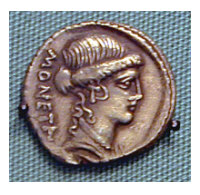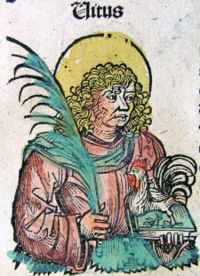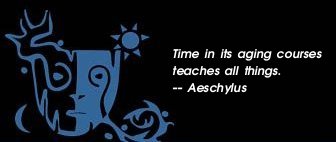|

June 2007
Find myth- and Mythic Journeys-related events on our
Annual Calendar
June 1 — Full Moon
The Algonquin Indians call this the Strawberry Moon because of the relatively short harvest season for that berry. Europeans call it the Rose Moon.
 Juno Moneta Juno Moneta
The Roman festival of Juno Moneta, the "Warner." In this aspect the goddess warned people of danger and women of bad marriages. Her temple contained the original mint, so Moneta became the source of the word "money."
Carna/Beans Kalends
On this day, the Romans honored Mars, the Storms, and the goddess Carna. They ate hot bacon and beans mixed with emmer wheat in honor of the goddess of the flesh, Carna, sometimes seen as the goddess of food assimilation, a personification of carnal reality and the physical processes necessary for survival.
Gawai Dayak (Malaysia)
This is the most important holiday celebrated in the state of Sarawak in the Republic of Malaysia. It marks the gathering of the rice harvest, proclaims the beginning of the new planting season (the new year), and is of spiritual significance. Evil spirits are appeased to insure a good harvest for the upcoming year. Ceremonies are held at midnight on the eve of Gawai Dayak. The day is marked with games, singing, dancing, feasting, family reunions, and public entertainments.
Clothes Changing Day (Japan)
Put away winter clothes and take out summer sandals, cotton dresses, and short sleeve shirts. Japanese school children and many companies switch to their summer uniforms. The change in the city landscape is visual and obvious. The fragile, pale, winter-shielded skin is freshly exposed to the light of the sun. People visit their local shrines to ask for protection. An old legend from central Honshu province says that snakes shed their skins on June 1st, and seeing a snake shed it's skin is thought to cause blindness, so people are warned to stay out of the field on that day.
June 2 — Republic Day (Italy)
 St. Elmo's Day St. Elmo's Day
St Elmo (also known as St. Erasmus) is one of those spurious saints whose gruesome martyrdom (having his intestines pulled out of his abdomen by being wound on a windlass or capstan) sets the tone for his patronage. Thus he became the patron saint of people with stomach ailments, colicky babies, women in labor, and sailors. His symbol is the windlass. More likely, as with other spurious saints, the story of his death was tailored to fit a depiction of St. Elmo preaching in front of a windlass in a storm. Earlier versions of St. Elmo were probably sea gods like Dionysus. He is now associated with the electrical discharges that spark around ships in stormy weather, said to be a sign that he is near protecting ocean travelers in peril.
June 3 — All Saints Day (Orthodox Christian)
Trinity Sunday (Christian)
Catholics set aside the day after Pentecost to honor the Trinity: Father, Son and Holy Ghost. E. Urlin in the book Festivals, Holy Days and Saints Days posits wryly that "the identification of this day with a dogma, rather than an event, or a personage, has tended to discourage the growth of folk-lore around it. At any rate, there is a certain dearth of Trinity Sunday customs recorded by English writers." Russians and Yugoslavians use this day to get out, collect birch branches and enjoy picnics. They cover church floors with grass and flowers. People weave wreaths during the morning services, then take them home to hang them below icons or over doors as symbols of blessing. The French in Lorraine hold the folk belief that you can see three suns rise on Trinity Sunday. In Saxony, pansies — known as Trinity flowers for their tripartate blossoms — are the primary decoration on this day.
Enoch Soames Day
A 1912 short story by Max Beerbohm introduced the main character of Enoch Soames, a struggling writer whose work is abstruse and unknown. He desperately sells his soul to the Devil in exchange for a trip into the future date of June 3, 1997 where he looks up his name in the catalogue of the Reading Room of the British Museum. The Devil comes to claim him as he learns, to his dismay, that he's only mentioned as an imaginary character created by Beerbohm. As he descends to hell he begs Beerbohm, "Try, try to make them know that I did exist." In 1997, the BBC celebrated this secular holiday by dramatizing the story and creating the Enoch Soames Society.
June 4 — Start of Rusalka Week
The Rusalki arrive on Monday, bringing with them a kind of lovesickness called Rusalka Sickness. During this dangerous week certain activities were forbidden. On Monday and Wednesday, women are not allowed to spin or weave, sleep during the day or wash their hair. Garlic and walnut leaves are worn for protection. Young girls gather flowers, join in a circle dance, and make bouquets for the men they love. A special group of men called Koluchari try to help people who are sick by singing songs. At the end of the ritual, they break ceramic pots to end the love sickness spell, returning all to normal.
 Bendidia Bendidia
This festival honoring the Thracian goddess Bendis falls on the 19th day of the Greek lunar month of Thargelion. In Plato's Republic, this Cappadocian goddess similar to Gaea, the Earth Mother, is depicted wearing a Phyrgian cap, the cloak and short tunic of a huntress, high fur-topped boots and carrying a spear. At the ritual in her honor, women offer her wheat.
June 6 — National Day (Sweden)
June 7 — Corpus Christi (Catholic Christian)
This festival, which takes place on the Thursday after Trinity Sunday, promotes the Catholic doctrine of transubstantiation: that the consecrated host becomes the actual Body of Christ. It features a procession during which the priest, in elaborately embroidered red and gold vestments, displays the host in a monstrance (golden vessel) shaped like a sunburst. The vessel is covered under a canopy of silk and a cloth of gold. The whole point is a conspicuous display of pomp and pageantry. Small altars are created along the roads. In France, they're called reposoirs and are built at crossroads. They are decorated with flowers, garlands and greens and covered with canopies of interwoven boughs. The priest goes around and blesses them. Corpus Christi is also a time for plays and pageants. Fantastically dressed performers accompany the processions and act out scenes from the Bible and the lives of the saints at stops along the way. In medieval times, each guild sponsored a scene in a grand play showing the whole scheme of Salvation. Some of the dramas were so long they could not be performed in their entirety: the Coventry cycle took two years. In Spello, Italy people transform the main street into a carpet of color using flower petals. The designs are complicated, and often reproduce famous religious paintings. When the priest emerges from the cathedral holding up the Host, he walks down the length of flower carpet, and the petals scatter to the breezes. It is an ephemeral, extravagant display of beauty and richness.
 Vestalia — (Ancient Rome) Vestalia — (Ancient Rome)
This holiday was celebrated in honor of the Roman fire goddess Vesta. Vesta's priestesses cleared and cleaned her altars, beautifying her temples. The penus (storehouse) in the temple was opened, and the first fruits of the grain harvest were prepared and offered in sacrifice to the gods. The Vestal Virgins prepared sacred foods including mola salsa, a cake of salt and the first grain. The water came from vessels that could not be set down without spilling, and the salt was pounded in a mortar, baked and sawn. Vesalia became a holiday for millers and bakers. Additionally, statues and smal images of people were cast into rivers in sacrifice. The word "virgin" meant "one within", so her Vestal Virgins were those who lived within the confines of her temple. During Vestalia, the innermost sacred areas of the temple were opened to all priestesses for prayer and ritual, but men were not allowed to enter Vesta's temple.
June 8 — St. Medard's Day
If on the eighth of June it rain
That foretells a wet harvest, men sayen
On the feast day of St. Medard, the French use the weather in the same maner as the English do with St Swithin's Day to forecast the coming weeks. If it rains, the rain will continue for four or five weeks, or recur at haying time. Wet weather in Norway on this day means that rain will last for forty days.
Mens
The ancient Romans honored the goddess Mens ("Mind") to fulfill a vow undertaken by Hannibal after a defeat in 217 BC.
 June 9 — St. Columba of Iona (Celtic Christian) June 9 — St. Columba of Iona (Celtic Christian)
Day of Colum Cille the beloved
Day to put the loom to use
Day to put sheep to pasture
Day to put coracle on the seas
Day to bear, day to die
Day to make prayer efficacious
Day of my beloved, the Thursday.
This is the luckiest day of the year when it falls on Thursday (as it does this year). The magical herb, St John's Wort, which flowers around summer solstice, was said to be St. Columba's favorite herb. He wore it underneath his armpit to ward off all kinds of evil. If you find some accidentally and you say this charm when you pick it, you can use it the same way:
Arm-pit package of Columba the kindly
Unsought by me, unlooked for
I shall not be carried away in my sleep
Neither shall I be pierced with iron
Better the reward of its virtues
Than a herd of white cattle.
Fornax
The Romans celebrated the festival of Fornax, goddess of ovens, by hanging garlands of flowers on ovens and wreaths on the necks of the mules who turned the mills.
June 10 — National Day (Portugal)
June 11 — Matralia/Fortuna
Roman women celebrated Mater Matuta, the goddess of dawn on this day. They asked for her blessings on their children or their sister's children. As part of the ritual, the women drove from the temple a slavewoman who represented night, thus symbolically enacting the arrival of Dawn. The temple of Mater Matuta was alongside one of Fortuna who was also worshipped on this day.
St. Barnaby's Day
Barnaby bright, Barnaby bright
Light all day and light all night.
 St Barnabas was invoked as a peacemaker. On his day, it was customary to deck churches and houses with Barnaby garlands of roses, sweet woodruff, yellow star thistle, and pink ragged robin. St Barnabas was invoked as a peacemaker. On his day, it was customary to deck churches and houses with Barnaby garlands of roses, sweet woodruff, yellow star thistle, and pink ragged robin.
When Barnabas smiles both night and day
Poor Ragged Robin blooms in the hay
At St Barnabas, the scythe in the meadow.
In Denmark, this day was the end of the contract year and masters and servants were free to renegotiate their contracts or part ways. It was also called The Devil's Birthday.
June 12 — National Day (Philipines)
St Onuphrius' Day
Greeks will not reap on this day because the saint, nicknamed Rufnis, will supposedly eat any fruits they harvest. His legend says he lived in a cave, dressed in a loincloth of leaves and subsisted entirely on dates. Catalan girls ask St Onuphrius for help finding wealthy husbands with this prayer:
Glorios sant Onofre, Glorious St Onuphrios
Deu-me un casador Give me a husband
Amb un bon cofre With a chest full of money.
 June 13 — Feast of Epona (Celtic) June 13 — Feast of Epona (Celtic)
Iron Age Celts worshipped Epona, the horse goddess in Hungary, central Europe, and Britain. She is depicted as a white horse who traveled the earth. This white horse was also the method of transportation for shaman and other humans traveling between the world of men and the faerie realms. Epona represented agriculture, transportation, and the tool of the warrior.
St. Anthony of Padua
St Anthony, a 13th century scholar and preacher, patron saint of horses and the poor, is also invoked to find lost property:
Tony, Tony, look around
Something's lost that must be found
Like Saint Onuphrius (see June12), he also helps women find rich husbands, if they burn a candle on his day and say this prayer:
Sant Antoni beneit Blessed St Antony,
Feu-me trobar un marit Make me find a husband
Que sigui bon home i ric Who is a good man and rich,
I, si pot ser, de seguit And if possible right away.
Apparently he also helps men with potency problems, as Reginald Scot reports in his chapter on Popish and magical cures. In one story, if a woman is not satisfied with her husband's readiness, she then makes a wax likeness of his member and places it on St Anthony's altar, asking that it be in be more courageous and of better disposition and ability.
In the Vodou tradition, he is associated with Ogun (Dragonslayer), the Wild Man of the Woods, Architect, Builder of Civilizations and God of Iron.
Lesser Quinquatrus
In ancient Rome, this was the start of a three day festival during which the guild of pipers (who played for sacrifices, funerals and feasts) celebrated with drinking, roaming the streets, dressing in masks and women's clothes and singing. The festivities began at the Temple of Minerva who (as Athena) invented the pipes.
June 14 — Birth of the Muses (Ancient Greece)
On this day the goddess Mnemosyne (whose name means 'memory') gave birth to nine daughters: Calliope (epic songs); Euterpe (lyric songs); Polyhymnia (sacred songs); Thalia (comedy); Melpomene (tragedy); Terpsichore (dance); Erato (poetry); Clio (history); and Urania (astronomy). The Muses brought an appreciation of the arts into the world with their inspiration of creativity, social and scientific studies.

New Moon in Gemini
This is the start of the Greek month of Skirephorion and the Jewish lunar month of Tammuz, named after the Sumerian shepherd-God, who was the lover of Inanna (Ishtar).
Dragon Moon
The fifth Chinese moon is called the Dragon Moon and is considered a dangerous month, especially for boys who have red threads tied around their wrists for protection. This belief in the danger of the fifth moon shows up in a memoir about the Moso people, a matrilineal ethnic group living on the border of China. People go out during the fifth month to collect horrid creatures like snakes, centipedes, spiders, toads, and bats. The mother warning her daughter says: "They take these animals home and put them in a jar. Then they close the lid and all the poisonous things fight and eat each other until, at the end, only one is left. That one is the Gu, and it's the most poisonous thing in the world."
June 15 — Sacred Heart of Jesus (Catholic Christian)
End of Vestalia
In ancient Rome, this day marked the end of the week of festivities devoted to Vesta (see June 7). Her temple was cleaned, the refuse thrown into the Tiber, the penus (inner storehouse) was closed up and the Vestals went back to their regular duties. This marked the first day in over six weeks considered propitious for marrying.
 St. Vitus Day St. Vitus Day
St. Vitus is one of those obscure fourth century martyrs. The story goes that his father, angry because his son had been converted to Christianity by his nurse and her husband, turned him over to the authorities. Angels danced for him while he was in prison, thus he is the patron of dancers, actors, mummers and those inflicted with fit-producing diseases like epilepsy and chorea (also known as St Vitus' Dance). He is also the patron saint of Bohemia and he helps those who have difficulty rising early. His emblem is a cock or a dog.
If St Vitus' day be rainy weather
It will rain for thirty days together
June 16 — Martydom of Guru Arjan Dev (Sikh)
June 17 — Father's Day
June 19 — New Church Day (Swedenborgian Christian)
June 21 — Litha or Midsummer (Wicca - Northern Hemisphere)
The holiday is considered the turning point, the longest day and the shortest night, at which summer reaches its height and the sun shines longest. It is celebrated around the world with the lighting of bonfires. This is the time when the faerie kingdoms travel, and it is not wise to spend time at crossroads. It is a good night for divination.
Yule (Wicca - Southern Hemisphere)
First Nations Day (Canadian Native People)
June 24 — St. John the Baptist (Christian)
June 29 — Feast Day of St Peter & St. Paul (Christian)
June 30 — Blue Moon
Sun Dance Ceremony (Native Plains Tribes)
Guru Purnima (Hindu)
Asala Puja Day (Dharma - Buddhist)
Hersephoria
On the fourteenth day of the Greek lunar month of Skirophorion, the full moon closest to the summer solstice, Greek women worshipped Aphrodite along with the dew-goddess Aglauros and Erse and the goddess Kourotrophos, "Nurturer of the young."
|

